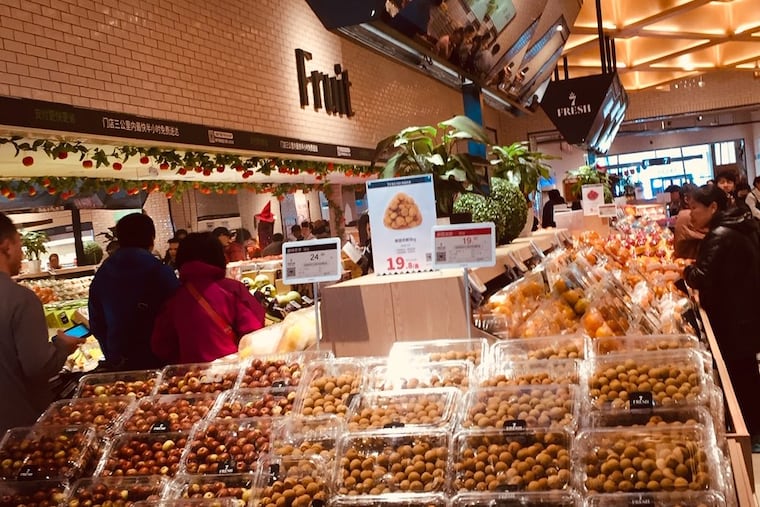China’s future weapon vs. America: Its growing middle class | Trudy Rubin
Already bigger than their counterparts in the U.S., the Chinese urban middle class shop in malls, buy seaside condos, and push their kids to go to university. China hopes their consumption habits will offset any tariff-driven decline in exports.

YANTAI, China — They shop in malls and high-end supermarkets, buy condos by the seaside, attend wine tastings, vacation abroad, and push their kids to apply to Harvard. But they aren't American suburbanites; they are China's huge and growing urban middle class, which Beijing hopes will eventually consume enough to lower the country's dependence on exports.
Whatever the outcome of the U.S.-China trade war – and any tête-à-tête between Presidents Trump and Xi Jinping at the upcoming G-20 meeting in Argentina – China's urban middle class is set to become a major driver of the global economy. And a major force in the wider world.
If you trust Chinese government figures, the middle class already tops 400 million, larger than the entire U.S. population. Even if you cut that figure in half, it outstrips the U.S. middle class of roughly 120 million. Moreover, despite far lower earnings than their Western counterparts, lower costs in China give them living standards approximating southern Europe.
And unlike their frugal parents and grandparents, who lived through China's poverty years and Cultural Revolution and are avid savers, younger Chinese are more eager to spend.
On a trip to Beijing, to Chengdu in western China, and to Yantai and Qingdao on the east coast, I saw a booming consumption culture that outstripped anything I'd seen in previous visits.
High-end, indoor malls everywhere sporting luxury western brands are already old news. Add to that a new chain of high-tech supermarkets called 7Fresh – the Chinese version of Whole Foods. I visited one in Beijing replete with glitzy packaging and lighting, and mobile shopping carts that follow you around. I watched sales people inform Chinese shoppers of every detail of where and how live lobsters, stone crabs, and other sea creatures were caught and delivered still breathing.
7Fresh is an offshoot of JD.com, an Amazon wannabe and part of China's e-commerce explosion, that has a China-wide delivery network replete with drones and bikes that can reach 90 percent of the country with same- and next-day delivery.
By the way — and this made me feel really archaic — almost no one pays with cash or credit cards these days in China: I watched everyone from kids to old ladies pull out cell phones and flash their Alipay mobile app (from Alibaba, the e-commerce giant). Payments are deducted from their bank accounts.
Old ladies with phones? As of early 2017, mainland Chinese consumers accounted for an estimated 243 million iPhone users, a third of all iPhones in use globally, according to research firm Newzoo. But there are excellent, far cheaper Chinese brands for those who want to spend less.
On the weekend, Beijing's 798 art district, in a decommissioned military factory, is jammed with Chinese spenders browsing its galleries, cafes, and restaurants. So is the area around Beijing's Beihai Lake, where old Chinese houses have been converted into shops. Young people eat ice cream in the shape of flowers and Peking duck shredded into Mexican-style tortillas.
And how does the middle class spend its vacations? In Yantai, a lovely port city 350 miles from Beijing, newish seaside hotels and restaurants line the oceanfront. Row after row of luxury apartment towers overlook white sandy beaches and the Yellow Sea across from South Korea; they are snapped up by well-heeled urban Chinese seeking to escape awful urban pollution — and find cheaper real estate.
Chinese tourists who want greater rustication can visit Majiagou Village, a former collective farm that has been converted into a tourist destination, as part of a government project to revitalize the countryside. Visitors can stay in a two-story hotel and take their children to pick Yantai's famous Fuji apples in local orchards (I picked some, and they were delicious.) Villagers said 300,000 visitors had arrived from all over China, as well as South Korea, since 2016.
On the more upscale end, I visited Yantai's Changyu winery, dating back to 1892, but now prospering from the new Chinese middle class's widening tastes. The Changyu Noble Dragon cabernet went down well in a lavish tasting room; reviews say that Chinese wine quality is seriously improving and exports to Europe are growing.
None of this is meant to disguise China's problems, including rural poverty and frayed social safety nets. Middle-class Chinese worry about an economic slowdown and about getting their kids into good schools or getting them visas to U.S. colleges (Some enroll their kids as young as 1 year old in weekday boarding schools with names such as Harvard Cradle, to expose them to intensive language and music training and boost their chances of winning admission to the best U.S. universities.)
In my conversations, worries about freedom of speech or political liberalization appear subordinated these days to economic concerns. No one can be certain what will happen in the future. But what impact this ambitious middle class will have on its own government and the world is the most fascinating question in China today.